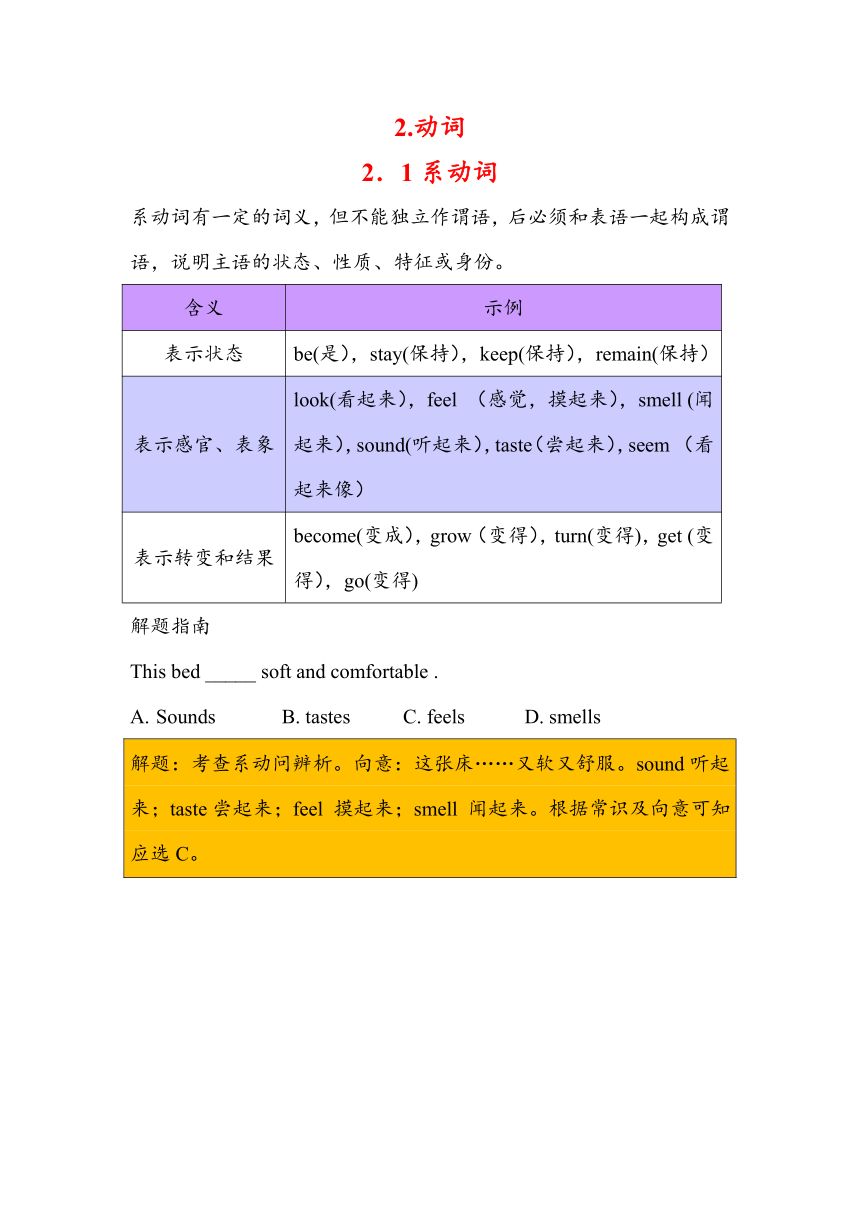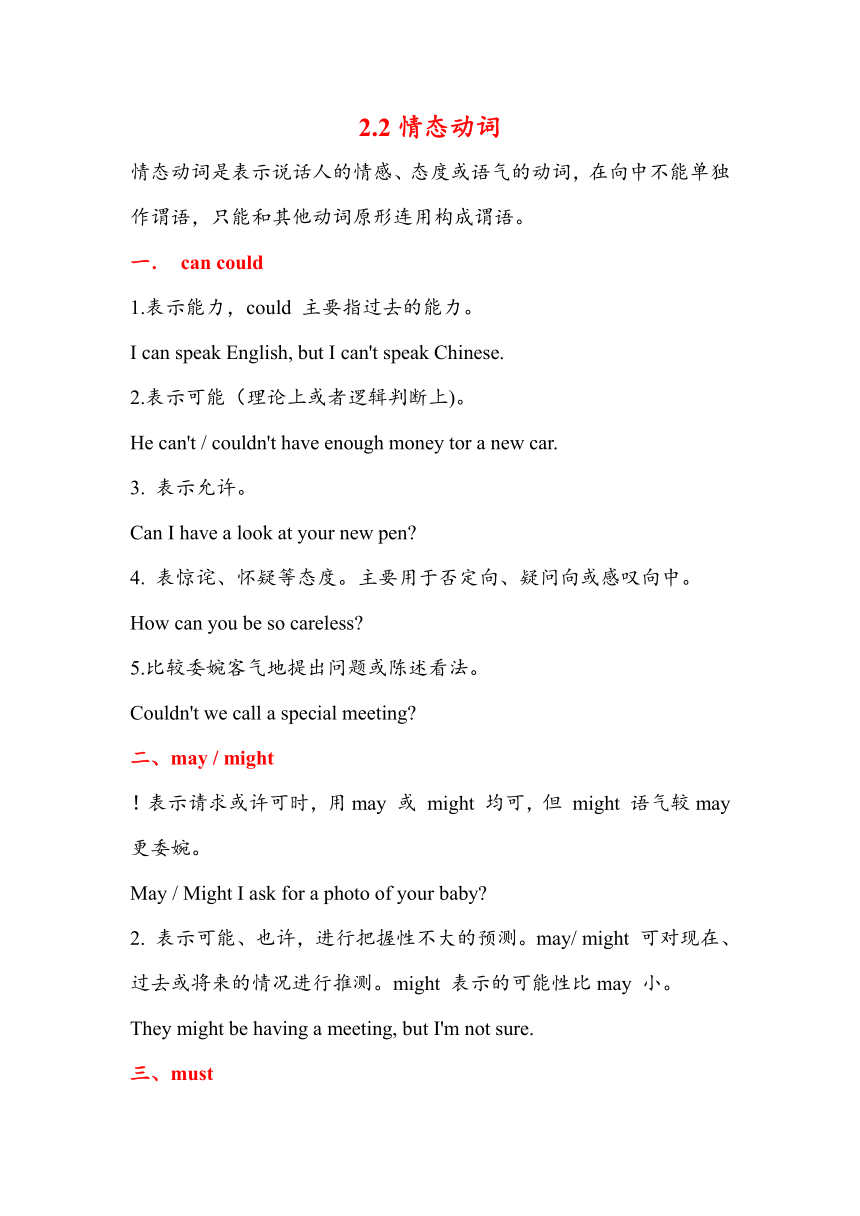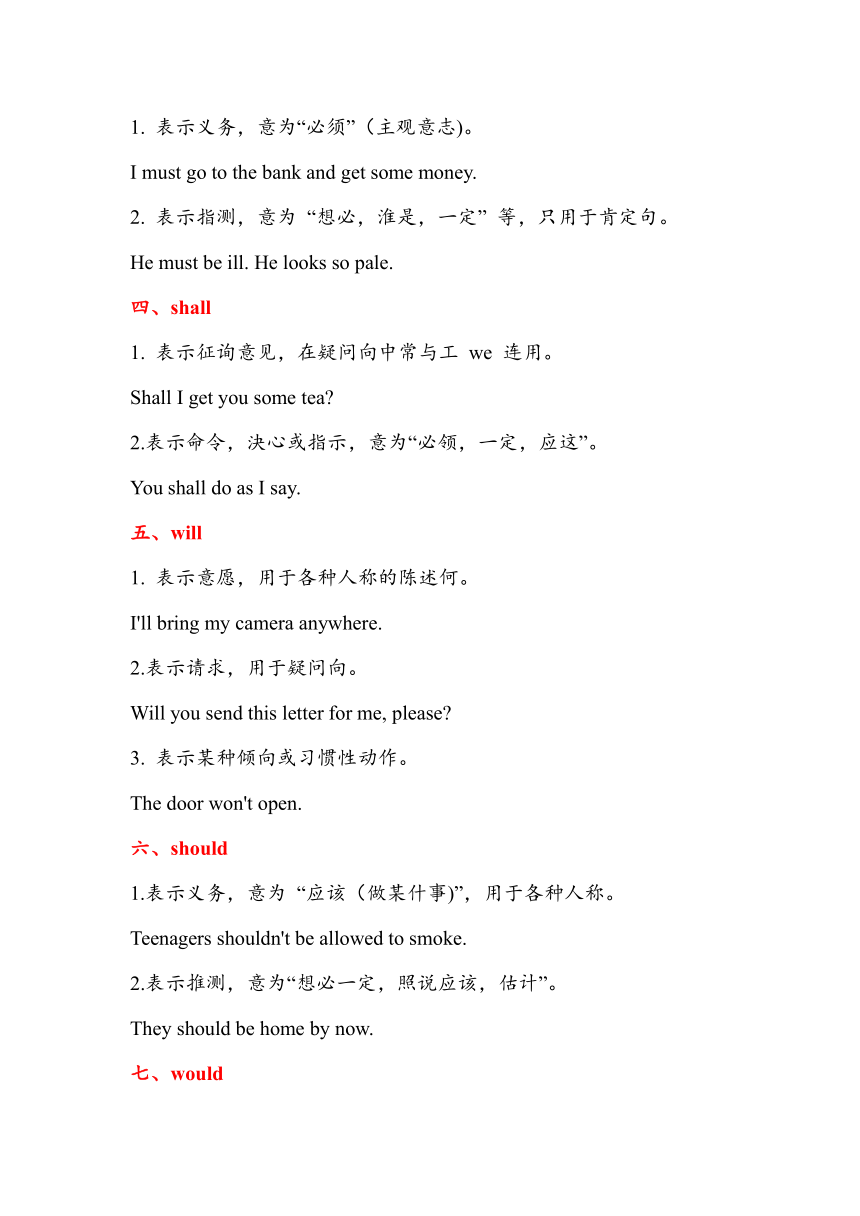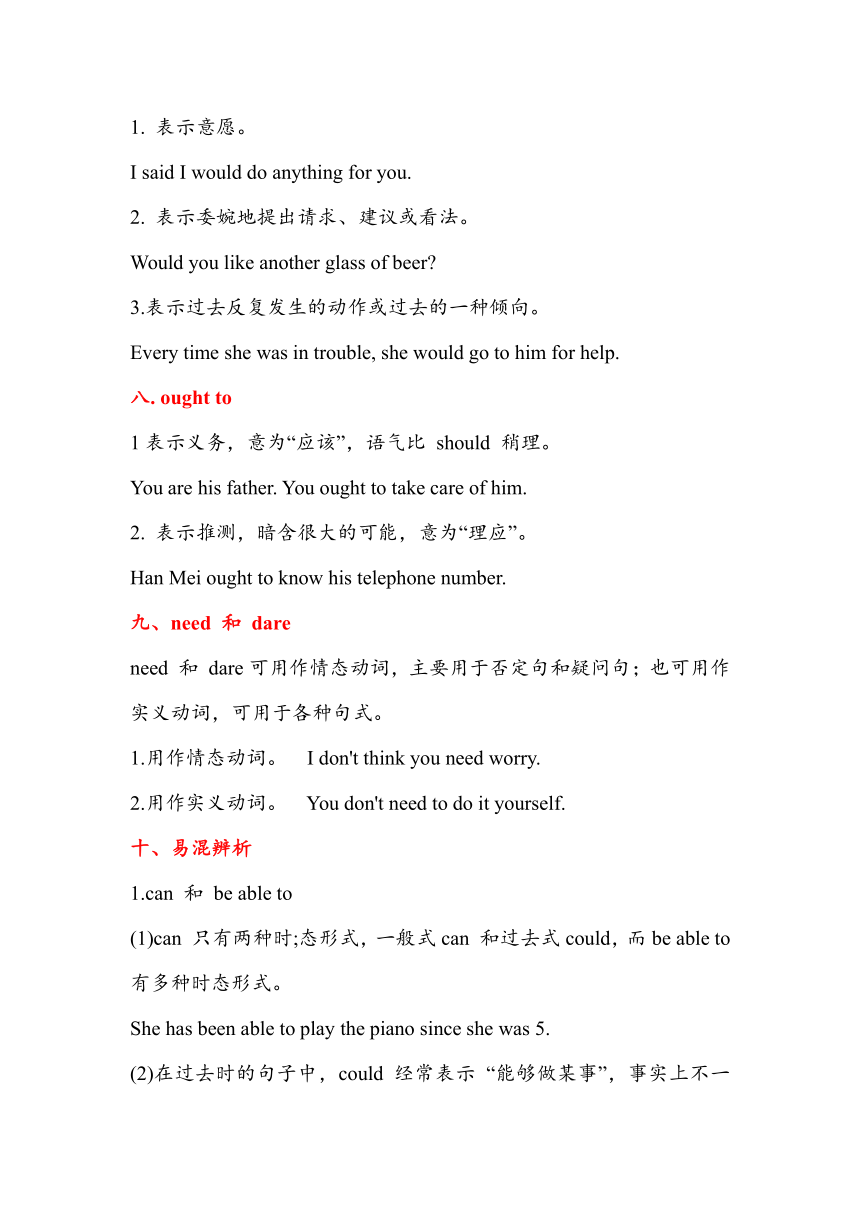2024年九年级中考英语语法——动词讲义
文档属性
| 名称 | 2024年九年级中考英语语法——动词讲义 |  | |
| 格式 | docx | ||
| 文件大小 | 32.3KB | ||
| 资源类型 | 教案 | ||
| 版本资源 | 通用版 | ||
| 科目 | 英语 | ||
| 更新时间 | 2024-02-06 13:44:01 | ||
图片预览




文档简介
2.动词
2.1系动词
系动词有一定的词义,但不能独立作谓语,后必须和表语一起构成谓语,说明主语的状态、性质、特征或身份。
含义 示例
表示状态 be(是),stay(保持),keep(保持),remain(保持)
表示感官、表象 look(看起来),feel (感觉,摸起来),smell (闻起来),sound(听起来),taste(尝起来),seem (看起来像)
表示转变和结果 become(变成),grow(变得),turn(变得),get (变得),go(变得)
解题指南
This bed _____ soft and comfortable .
Sounds B. tastes C. feels D. smells
解题:考查系动问辨析。向意:这张床……又软又舒服。sound听起来;taste尝起来;feel 摸起来;smell 闻起来。根据常识及向意可知应选C。
2.2情态动词
情态动词是表示说话人的情感、态度或语气的动词,在向中不能单独作谓语,只能和其他动词原形连用构成谓语。
一. can could
1.表示能力,could 主要指过去的能力。
I can speak English, but I can't speak Chinese.
2.表示可能(理论上或者逻辑判断上)。
He can't / couldn't have enough money tor a new car.
3. 表示允许。
Can I have a look at your new pen
4. 表惊诧、怀疑等态度。主要用于否定向、疑问向或感叹向中。
How can you be so careless
5.比较委婉客气地提出问题或陈述看法。
Couldn't we call a special meeting
二、may / might
!表示请求或许可时,用may 或 might 均可,但 might 语气较may 更委婉。
May / Might I ask for a photo of your baby
2. 表示可能、也许,进行把握性不大的预测。may/ might 可对现在、过去或将来的情况进行推测。might 表示的可能性比may 小。
They might be having a meeting, but I'm not sure.
三、must
1. 表示义务,意为“必须”(主观意志)。
I must go to the bank and get some money.
2. 表示指测,意为 “想必,淮是,一定” 等,只用于肯定句。
He must be ill. He looks so pale.
四、shall
1. 表示征询意见,在疑问向中常与工 we 连用。
Shall I get you some tea
2.表示命令,決心或指示,意为“必领,一定,应这”。
You shall do as I say.
五、will
1. 表示意愿,用于各种人称的陈述何。
I'll bring my camera anywhere.
2.表示请求,用于疑问向。
Will you send this letter for me, please
3. 表示某种倾向或习惯性动作。
The door won't open.
六、should
1.表示义务,意为 “应该(做某什事)”,用于各种人称。
Teenagers shouldn't be allowed to smoke.
2.表示推测,意为“想必一定,照说应该,估计”。
They should be home by now.
七、would
1. 表示意愿。
I said I would do anything for you.
2. 表示委婉地提出请求、建议或看法。
Would you like another glass of beer
3.表示过去反复发生的动作或过去的一种倾向。
Every time she was in trouble, she would go to him for help.
八. ought to
1表示义务,意为“应该”,语气比 should 稍理。
You are his father. You ought to take care of him.
2. 表示推测,暗含很大的可能,意为“理应”。
Han Mei ought to know his telephone number.
九、need 和 dare
need 和 dare可用作情态动词,主要用于否定句和疑问句;也可用作实义动词,可用于各种句式。
1.用作情态动词。 I don't think you need worry.
2.用作实义动词。 You don't need to do it yourself.
十、易混辨析
1.can 和 be able to
(1)can 只有两种时;态形式,一般式can 和过去式could,而be able to 有多种时态形式。
She has been able to play the piano since she was 5.
(2)在过去时的句子中,could 经常表示 “能够做某事”,事实上不一定去做,而was/ were able to 则表示 “过去做成了某事”。在肯定句中两者可通用。
He could swim across the English Channel. But he didn't feel like it that day.
Thanks to your help, we were able to make it possible for those kids to have a new home.
2.must 和 have to
must 表示主观意志,意为“必须”,而have to 表示由于客观因素不得不做某事,意为 “不得不”;must 只有一种形式,而have to 有多种时;态形式;must 的否定式为mustn't,意为“不准,不允许”,而 have to 的否定式为 don't / doesn't have to,意为“不必”,相当于 needn't
I told her that she must give up smoking.
I had to visit many stores before finding a pair made in America.
解题指南
典例——Mom , _____ I visit the Modern Art Museum next Monday
——I'm afraid you can't. All the city museums are closed on Monday.
A. would B. need C. should D. may
学霸解题
考查情态动词饼析。句意:——妈妈,下周一我……参观现代艺术博物馆吗?——恐怕你不能。这个城市所有的博物周一都不开放。would愿意;need需;should 应孩;may可以根据句意和间义可知,答案为D项。
2.3 助动词
助动词本身没有意义,只是帮助实义动词完成某些语法功能
一、be
be有am, is, are, was, were, being, been 七种形式。
1.am,is, are, was, were 与现在分词连用构成进行时。
I'm watching TV.
2.am,is,are, was, were 与过去分词连用构成被动语态。
English is spoken as a second language in many parts of India.
二. do
do 有do, does, did 三种形式。
1.do和does 用于构成一般现在时的否定向和疑问句。
——Does he have a soccer ball
——No, he doesn't.
2.did 用于构成一股过去时的否定句和疑问句。
So when did it become popular
三. have
have 有have, has, had 三种形式。与过去分词连用构成完成时。
——Have you watered the plants yet
——Yes, I have already watered them.
2.4 使役动词
一、使役动词接不定式作宾语补足语
let, make, have 等后加省略10的不定式作宾补。常见短语:have / make / let sb. do sth. 让某人干某事
Please let us know which is the best to travel by plane, train or bus.
二、使役动词接过去分词作宾语补足语
常见短语:
have sth. done 让别人干某事;某物遭受…
make sb. / sth. done 使某人/ 某物…(其中sb.常用反身代词)
let sth. done 让某事被…
He raised his voice to make himself heard
三、使役动词的被动语态需要在其后面加to。
He made me laugh.(主)
Iwas made to laugh by him.(被)
2.5 动词辨析
一、三个“借”
borrow“借入”,borrow sth from sb. 向某人借某物
lend“借出”,lend sth to sb. 把某物借给某人
keep“借”,延续性动词,与表示时间段的状语连用
二、四个“带”
bring“带来;拿来”,与说话人/地点越来越近
take“拿走;带走”,与说话人/地点越来越远
fetch“去拿来”,去某地将某物带回,强调往返
carry“提;拿;运”,无方向化
三、两个“赢”
beat“打败;击败”,后接对手
win“战胜;赢”,后接比赛、战争、奖品等
四、两个“听”
hear“听到”,强调听的结果
listen“听”,强调听的动作,不及物动词,和to搭配
五、三个“看”
look“看”,强调看的动作,不及物动词,和at搭配
see“看;看到”,强调看的结果和内容
watch“观看”,后接节目或比赛
六、四个“说”
say“说”,强调说的内容
speak“说(语言等)”,常见搭配:speak+语言
tell“讲述;告诉”,tell sb. sth=tell sth to sb.告诉某人某事
talk“交谈;谈论”,talk with sb.,talk to sb. 和某人交流
2.1系动词
系动词有一定的词义,但不能独立作谓语,后必须和表语一起构成谓语,说明主语的状态、性质、特征或身份。
含义 示例
表示状态 be(是),stay(保持),keep(保持),remain(保持)
表示感官、表象 look(看起来),feel (感觉,摸起来),smell (闻起来),sound(听起来),taste(尝起来),seem (看起来像)
表示转变和结果 become(变成),grow(变得),turn(变得),get (变得),go(变得)
解题指南
This bed _____ soft and comfortable .
Sounds B. tastes C. feels D. smells
解题:考查系动问辨析。向意:这张床……又软又舒服。sound听起来;taste尝起来;feel 摸起来;smell 闻起来。根据常识及向意可知应选C。
2.2情态动词
情态动词是表示说话人的情感、态度或语气的动词,在向中不能单独作谓语,只能和其他动词原形连用构成谓语。
一. can could
1.表示能力,could 主要指过去的能力。
I can speak English, but I can't speak Chinese.
2.表示可能(理论上或者逻辑判断上)。
He can't / couldn't have enough money tor a new car.
3. 表示允许。
Can I have a look at your new pen
4. 表惊诧、怀疑等态度。主要用于否定向、疑问向或感叹向中。
How can you be so careless
5.比较委婉客气地提出问题或陈述看法。
Couldn't we call a special meeting
二、may / might
!表示请求或许可时,用may 或 might 均可,但 might 语气较may 更委婉。
May / Might I ask for a photo of your baby
2. 表示可能、也许,进行把握性不大的预测。may/ might 可对现在、过去或将来的情况进行推测。might 表示的可能性比may 小。
They might be having a meeting, but I'm not sure.
三、must
1. 表示义务,意为“必须”(主观意志)。
I must go to the bank and get some money.
2. 表示指测,意为 “想必,淮是,一定” 等,只用于肯定句。
He must be ill. He looks so pale.
四、shall
1. 表示征询意见,在疑问向中常与工 we 连用。
Shall I get you some tea
2.表示命令,決心或指示,意为“必领,一定,应这”。
You shall do as I say.
五、will
1. 表示意愿,用于各种人称的陈述何。
I'll bring my camera anywhere.
2.表示请求,用于疑问向。
Will you send this letter for me, please
3. 表示某种倾向或习惯性动作。
The door won't open.
六、should
1.表示义务,意为 “应该(做某什事)”,用于各种人称。
Teenagers shouldn't be allowed to smoke.
2.表示推测,意为“想必一定,照说应该,估计”。
They should be home by now.
七、would
1. 表示意愿。
I said I would do anything for you.
2. 表示委婉地提出请求、建议或看法。
Would you like another glass of beer
3.表示过去反复发生的动作或过去的一种倾向。
Every time she was in trouble, she would go to him for help.
八. ought to
1表示义务,意为“应该”,语气比 should 稍理。
You are his father. You ought to take care of him.
2. 表示推测,暗含很大的可能,意为“理应”。
Han Mei ought to know his telephone number.
九、need 和 dare
need 和 dare可用作情态动词,主要用于否定句和疑问句;也可用作实义动词,可用于各种句式。
1.用作情态动词。 I don't think you need worry.
2.用作实义动词。 You don't need to do it yourself.
十、易混辨析
1.can 和 be able to
(1)can 只有两种时;态形式,一般式can 和过去式could,而be able to 有多种时态形式。
She has been able to play the piano since she was 5.
(2)在过去时的句子中,could 经常表示 “能够做某事”,事实上不一定去做,而was/ were able to 则表示 “过去做成了某事”。在肯定句中两者可通用。
He could swim across the English Channel. But he didn't feel like it that day.
Thanks to your help, we were able to make it possible for those kids to have a new home.
2.must 和 have to
must 表示主观意志,意为“必须”,而have to 表示由于客观因素不得不做某事,意为 “不得不”;must 只有一种形式,而have to 有多种时;态形式;must 的否定式为mustn't,意为“不准,不允许”,而 have to 的否定式为 don't / doesn't have to,意为“不必”,相当于 needn't
I told her that she must give up smoking.
I had to visit many stores before finding a pair made in America.
解题指南
典例——Mom , _____ I visit the Modern Art Museum next Monday
——I'm afraid you can't. All the city museums are closed on Monday.
A. would B. need C. should D. may
学霸解题
考查情态动词饼析。句意:——妈妈,下周一我……参观现代艺术博物馆吗?——恐怕你不能。这个城市所有的博物周一都不开放。would愿意;need需;should 应孩;may可以根据句意和间义可知,答案为D项。
2.3 助动词
助动词本身没有意义,只是帮助实义动词完成某些语法功能
一、be
be有am, is, are, was, were, being, been 七种形式。
1.am,is, are, was, were 与现在分词连用构成进行时。
I'm watching TV.
2.am,is,are, was, were 与过去分词连用构成被动语态。
English is spoken as a second language in many parts of India.
二. do
do 有do, does, did 三种形式。
1.do和does 用于构成一般现在时的否定向和疑问句。
——Does he have a soccer ball
——No, he doesn't.
2.did 用于构成一股过去时的否定句和疑问句。
So when did it become popular
三. have
have 有have, has, had 三种形式。与过去分词连用构成完成时。
——Have you watered the plants yet
——Yes, I have already watered them.
2.4 使役动词
一、使役动词接不定式作宾语补足语
let, make, have 等后加省略10的不定式作宾补。常见短语:have / make / let sb. do sth. 让某人干某事
Please let us know which is the best to travel by plane, train or bus.
二、使役动词接过去分词作宾语补足语
常见短语:
have sth. done 让别人干某事;某物遭受…
make sb. / sth. done 使某人/ 某物…(其中sb.常用反身代词)
let sth. done 让某事被…
He raised his voice to make himself heard
三、使役动词的被动语态需要在其后面加to。
He made me laugh.(主)
Iwas made to laugh by him.(被)
2.5 动词辨析
一、三个“借”
borrow“借入”,borrow sth from sb. 向某人借某物
lend“借出”,lend sth to sb. 把某物借给某人
keep“借”,延续性动词,与表示时间段的状语连用
二、四个“带”
bring“带来;拿来”,与说话人/地点越来越近
take“拿走;带走”,与说话人/地点越来越远
fetch“去拿来”,去某地将某物带回,强调往返
carry“提;拿;运”,无方向化
三、两个“赢”
beat“打败;击败”,后接对手
win“战胜;赢”,后接比赛、战争、奖品等
四、两个“听”
hear“听到”,强调听的结果
listen“听”,强调听的动作,不及物动词,和to搭配
五、三个“看”
look“看”,强调看的动作,不及物动词,和at搭配
see“看;看到”,强调看的结果和内容
watch“观看”,后接节目或比赛
六、四个“说”
say“说”,强调说的内容
speak“说(语言等)”,常见搭配:speak+语言
tell“讲述;告诉”,tell sb. sth=tell sth to sb.告诉某人某事
talk“交谈;谈论”,talk with sb.,talk to sb. 和某人交流
同课章节目录
